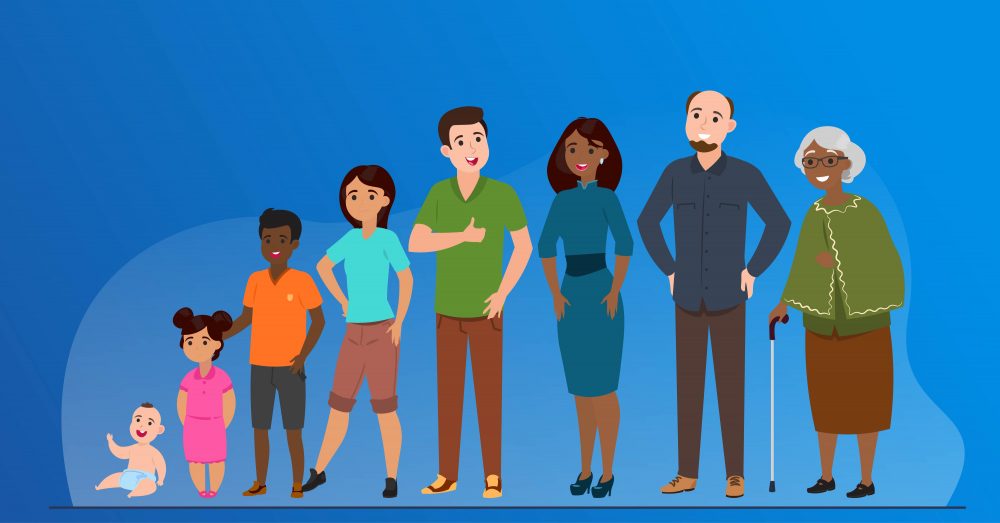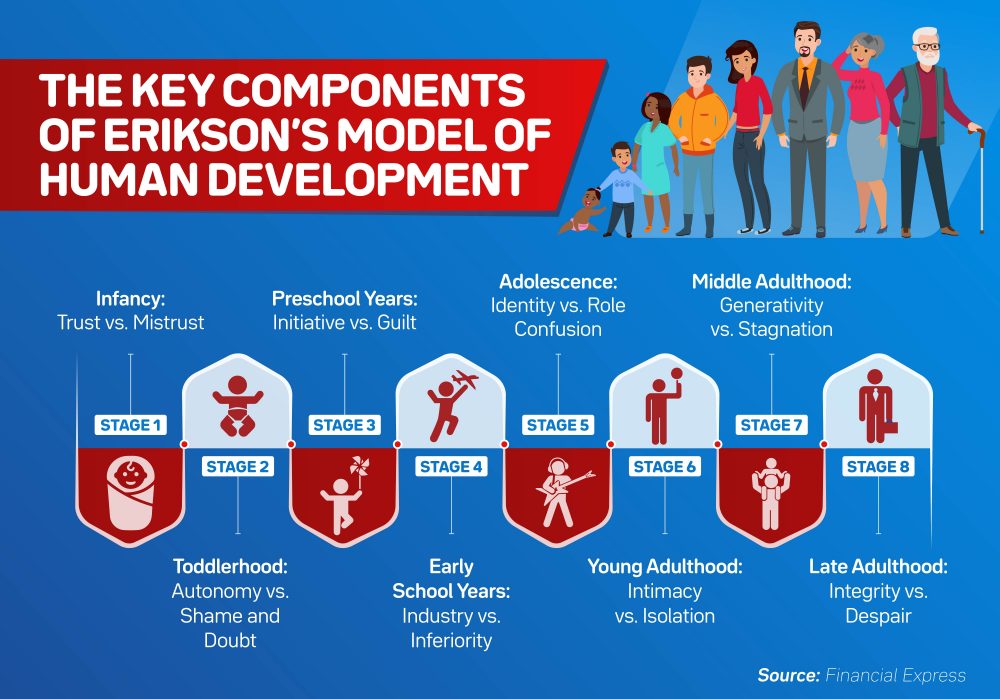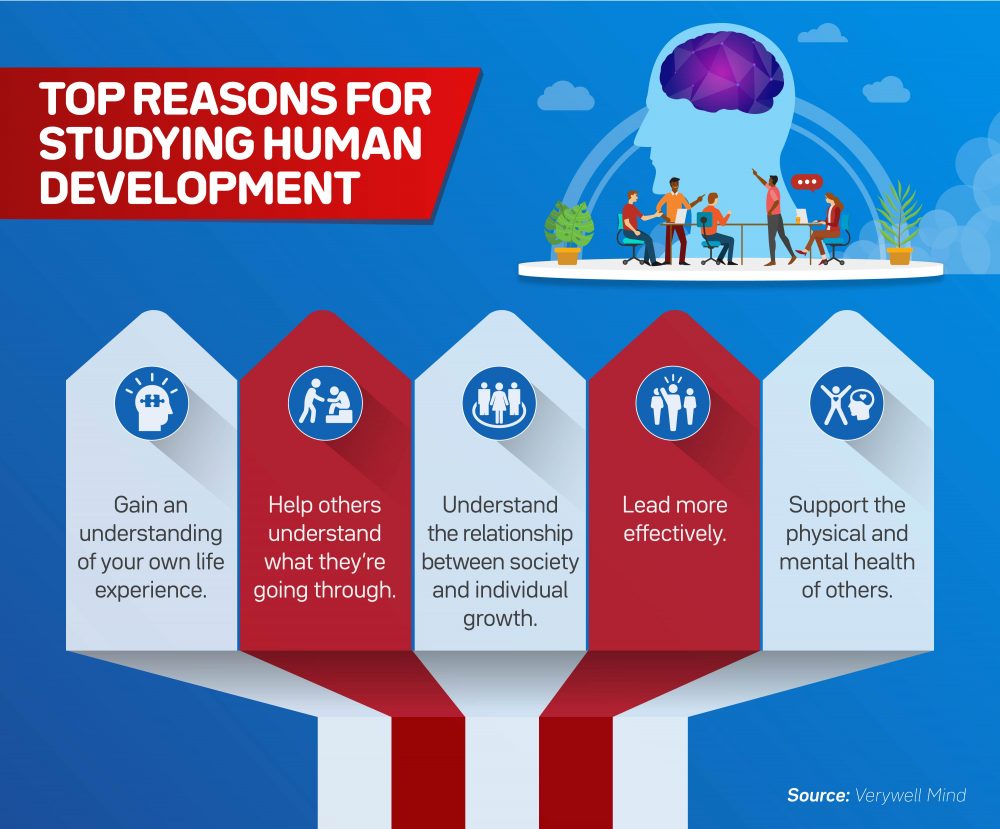What Is Human Development and Why Is It Important?What Is Human Development and Why Is It Important?What Is Human Development and Why Is It Important?
Tables of Contents
Imagine two children born in the same town and the same year to families with similar socioeconomic statuses. One child grows up to be assertive and confident, while the other grows up to be timid and shy. The study of the stages of human development can help explain the reasons for these differences and much more.
What is human development, exactly? Human development is a branch of psychology with the goal of understanding people — how they develop, grow, and change throughout their lives. This discipline, which can help individuals better understand themselves and their relationships, is broad. As such, it can be used in various professional settings and career paths.

What Are the Eight Stages of Human Development?
If human development is the study of how people change throughout their lives, how and when does this development happen? Many scientists and psychologists have studied various aspects of human development, including ego psychologist Erik Erikson. He examined the impact of social experiences throughout an individual’s life and theorized that psychosocial development happens in eight sequential parts. What are the eight stages of human development?
Stage 1 — Infancy: Trust vs. Mistrust
In the first stage of human development, infants learn to trust based on how well their caregivers meet their basic needs and respond when they cry. If an infant cries out to be fed, the parent can either meet this need by feeding and comforting the infant or not meet this need by ignoring the infant. When their needs are met, infants learn that relying on others is safe; when their needs go unmet, infants grow up to be less trusting.
Stage 2 — Toddlerhood: Autonomy vs. Shame and Doubt
In addition to autonomy versus shame and doubt, another way to think of the second stage is independence versus dependence. Like in the first stage, toddlers go through this stage responding to their caregivers. If caregivers encourage them to be independent and explore the world on their own, toddlers will grow up with a sense of self-efficacy. If the caregivers hover excessively or encourage dependence, these toddlers grow up with less confidence in their abilities.
For example, if a toddler wants to walk without assistance in a safe area, the caregiver should encourage this autonomy by allowing the independent behavior. If the caregiver insists on holding the toddler’s hand even when it’s not necessary, this attention can lead to doubt later in life.
Stage 3 — Preschool Years: Initiative vs. Guilt
During the preschool years, children learn to assert themselves and speak up when they need something. Some children may state that they’re sad because a friend stole their toy. If this assertiveness is greeted with a positive reaction, they learn that taking initiative is helpful behavior. However, if they’re made to feel guilty or ashamed for their assertiveness, they may grow up to be timid and less likely to take the lead.
Stage 4 — Early School Years: Industry vs. Inferiority
When children begin school, they start to compare themselves with peers. If children feel they’re accomplished in relation to peers, they develop strong self-esteem. If, however, they notice that other children have met milestones that they haven’t, they may struggle with self-esteem. For example, a first grader may notice a consistently worse performance on spelling tests when compared with peers. If this becomes a pattern, it can lead to feelings of inferiority.

The key components of Erikson’s model of human development include stage one, infancy, trust versus mistrust; stage two, toddlerhood, autonomy versus shame and doubt; stage three, preschool years, initiative versus guilt; stage four, early school years, industry versus inferiority; stage five, adolescence, identity versus role confusion; stage six, young adulthood, intimacy versus isolation; stage seven, middle adulthood, generativity versus stagnation; and stage eight, late adulthood, integrity versus despair.
Stage 5 — Adolescence: Identity vs. Role Confusion
The adolescent stage is where the term “identity crisis” originated, and for good reason. Adolescence is all about developing a sense of self. Adolescents who can clearly identify who they are grow up with stronger goals and self-knowledge than teenagers who struggle to break free of their parents’ or friends’ influences. Adolescents who still deeply depend on their parents for social interaction and guidance may experience more role confusion than teenagers who pursue their own interests.
Stage 6 — Young Adulthood: Intimacy vs. Isolation
In young adulthood, which begins roughly at age 20, people begin to solidify their lifelong bonds; many people enter committed relationships or marriages, while others form lifelong friendships. People who can create and maintain these relationships reap the emotional benefits, while those who struggle to maintain relationships may suffer from isolation. A young adult who develops strong friendships in college may feel more intimacy than one who struggles to form and maintain close friendships.
Stage 7 — Middle Adulthood: Generativity vs. Stagnation
In middle adulthood, people tend to struggle with their contributions to society. They may be busy raising children or pursuing careers. Those who feel that they’re contributing experience generativity, which is the sense of leaving a legacy. On the other hand, those who don’t feel that their work or lives matter may experience feelings of stagnation. For example, a middle-aged adult who’s raising a family and working in a career that presumably helps people may feel more fulfilled than an adult who’s working at a day job that feels meaningless.
Stage 8 — Late Adulthood: Integrity vs. Despair
As adults reach the end of life, they look back on their lives and reflect. Adults who feel fulfilled by their lives, either through a successful family or a meaningful career, reach ego integrity, in which they can face aging and dying with peace. If older adults don’t feel that they’ve lived a good life, they risk falling into despair.
Other Theories of Human Development
Although widely used, Erikson’s psychosocial development theory has been critiqued for focusing too much on childhood. Critics claim that his emphasis makes the model less representative of the growth that people experienced in adulthood. Erikson’s model of the stages of human development is only one theory addressing growth and change throughout life, as many other psychologists have researched their own theories of human development, including the following:
Cognitive Development
Jean Piaget developed the theory of cognitive development. Piaget’s theory is widely used in education programs to prepare teachers to instruct students in developmentally appropriate ways. The theory is based on four stages:
- Sensorimotor — In the sensorimotor stage (birth to 2 years old), children learn object permanence, which is the understanding that people and objects still exist even when they’re out of view.
- Preoperational — In the preoperational stage (2-7 years old), children develop symbolic thought, which is when they begin to progress from concrete to abstract thinking. Children in this stage often have imaginary friends.
- Concrete operational — In the concrete operational stage (7-11 years old), children solidify their abstract thinking and begin to understand cause and effect and logical implications of actions.
- Formal operational — In the formal operational stage (adolescence to adulthood), humans plan for the future, think hypothetically, and assume adult responsibilities.
Moral Development
Lawrence Kohlberg created a theory of human development based on moral development concepts. The theory comprises the following stages:
- Preconventional — In the preconventional stage, people follow rules because they’re afraid of punishment and make choices only with their best interests in mind.
- Conventional — In the conventional stage, people act to avoid society’s judgment and follow rules to maintain the systems and structures that are already in place.
- Postconventional — In the postconventional stage, a genuine concern for the welfare of others and the greater good of society guides people.
Psychosexual Theory
Sigmund Freud popularized the psychosexual theory. The theory comprises five stages:
- Oral — In the oral stage (birth to 1 year old), children learn to suck and swallow and may experience conflict with weaning.
- Anal — In the anal stage (1-3 years old), children learn to withhold or expel feces and may experience conflict with potty training.
- Phallic — In the phallic stage (3-6 years old), children discover that their genitals can give them pleasure.
- Latency — In the latency stage (roughly 6 years old through puberty), they take a break from these physical stages and instead develop mentally and emotionally.
- Genital — In the genital stage (puberty through adulthood), people learn to express themselves sexually.
Ideally, children move through each phase fluidly as their sexual libidos develop, but if they’re stuck in any of the phases, they may develop a fixation that hinders their development.
Behavioral Theory
The behavioral theory focuses solely on a person’s behaviors rather than the feelings that go alongside those behaviors. It suggests that behaviors are conditioned in an environment due to certain stimuli. Behavioral theorists believe that behavior determines feelings, so changing behaviors is important because this will in turn change feelings.
The attachment theory focuses on the deep relationships between people across their lifetime. An important attachment theory finding is that children must develop at least one strong bond in childhood to trust and develop relationships as adults. The attachment theory comprises four stages:
- Asocial or pre-attachment (birth to 6 weeks old)
- Indiscriminate attachment (6 weeks old to 7 months old)
- Specific or discriminate attachment (7-9 months old)
- Multiple attachments (10 months old or later)
Social Learning Theory
The social learning theory builds upon the behavioral theory and postulates that people learn best by observing the behavior of others. They watch how others act, view the consequences, and then make decisions regarding their own behavior accordingly. The four stages in this theory are:
- Attention
- Retention
- Reproduction
- Motivation
In the attention stage, people first notice the behavior of others. In the retention stage, they remember the behavior and the resulting consequences. In the reproduction stage, people develop the ability to imitate the behaviors they want to reproduce, and in the motivation stage, they perform these behaviors.
Sociocultural Theory
The sociocultural theory ties human development to the society or culture in which people live. It focuses on the contributions that society as a whole makes to individual human development. For example, children who are raised to play outdoors develop differently from children who are raised to play indoors.
An important part of this theory is the zone of proximal development, which is an area of knowledge and skills slightly more advanced than a child’s current level. The zone of proximal development helps teachers think about and plan instruction, so sociocultural theory plays a large role in preservice teacher training.
Resources: More Information on Theories of Human Development
- BetterHelp, “Behavioral Theory, Behavioral Psychology, or Behaviorism? How Behavior and Personality Intersect”
- Encyclopedia Britannica, “Lawrence Kohlberg’s Stages of Moral Development”
- Healthline, “What Are Freud’s Psychosexual Stages of Development?”
- PositivePsychology.com, “What Is Attachment Theory? Bowlby’s 4 Stages Explained”
- Psychology Today, Social Learning Theory
- SimplyPsychology, “Lev Vygotsky’s Sociocultural Theory”
- SimplyPsychology, Theories of Psychology
- Verywell Mind, “The 4 Stages of Cognitive Development”
Human Development vs. Developmental Psychology
What are the differences between human development and developmental psychology? These terms are closely related. In fact, the study of developmental psychology is most people’s entry into human development.
Developmental psychology is defined as a scientific approach to explaining growth, change, and consistency throughout a lifetime. It uses various frameworks to understand how people develop and transform throughout their lives. The goals of developmental psychology are to describe, explain, and optimize development to improve people’s lives. In the real world, developmental psychology is used in the study of physical, psychological, emotional, social, personality, and perceptual development.
The study of developmental psychology can lead to careers in several different fields. Developmental psychologists often work in colleges and universities and focus on research and teaching. Others work in healthcare facilities, clinics, assisted living facilities, hospitals, mental health clinics, or homeless shelters. In these applied settings, their focus is more on assessing, evaluating, and treating people. According to June 2020 data from PayScale, developmental psychologists earn an average annual salary of about $68,000.
What Are the Genetic Factors That Affect Human Growth and Development?
One more key element of human growth and development left to explore is genetics. Genetics influences the speed and way in which people develop, though other factors, such as parenting, education, experiences, and socioeconomic factors, are also at play. The multiple genetic factors that affect human growth and development include genetic interactions and sex chromosome abnormalities.
Genetic Interactions
Genes can act in an additive way or sometimes conflict with one another. For example, a child with one tall parent and one short parent may end up between the two of them, at average height. Other times, genes follow a dominant-recessive pattern. If one parent has brown hair and the other has red hair, the red hair gene is the dominant gene if their child has red hair.
Gene-Environment Interactions
Humans’ genetic information is always interacting with the environment, and sometimes this can impact development and growth. For example, if a child in utero is exposed to drugs, the child’s cognitive abilities may be impacted, thus changing the developmental process. In addition, even if a child’s genes would indicate a tall height, if that child experiences poor nutrition as children, it may impact their height.
Sex Chromosome Abnormalities
Sex chromosome abnormalities impact as many as 1 in 500 births. The following syndromes are examples of sex chromosome abnormalities that can impact development:
- Klinefelter syndrome is the presence of an extra X chromosome in males, which can cause physical characteristics such as decreased muscle mass and reduced body hair and may cause learning disabilities.
- Fragile X syndrome is caused by a mutation in the FMR1 gene that makes the X chromosome appear fragile. It can cause intellectual disability, developmental delays, or distinctive physical features such as a long face.
- Turner syndrome happens when one of the X chromosomes is missing or partially missing. It only affects females and results in physical characteristics like short stature and webbed neck.
Down Syndrome
Down syndrome is another common example of how genetics can impact development. This chromosomal disorder may cause some individuals to experience physical or intellectual development differences. Down syndrome occurs at the 21st chromosomal site, in which people with Down syndrome have three chromosomes rather than two.
Those with Down syndrome often have different physical characteristics and may be prone to physical problems like heart defects and hearing problems. Most individuals with Down syndrome have intellectual impairment, but the degree of this impairment varies from person to person.

The top reasons for studying human development are to gain an understanding of your own life experience, help others understand what they’re going through, understand the relationship of society and individual growth, lead more effectively, and support the physical and mental health of others.
Why Do We Study Human Growth and Development?
The study of human growth and development offers a wealth of value for personal and professional growth and understanding. Many reasons exist for why we study human growth and development.
Common benefits include the following:
- To gain a better understanding of one’s own life experiences. This can help people personally reach an understanding of what childhood events shaped their adulthood.
- To gain knowledge of how social context impacts development. This knowledge can be invaluable for professionals like teachers as they gain a deeper understanding of their students.
- To help others understand and contextualize the ups and downs of life. This helps therapists and psychologists better aid their clients in self-discovery.
- To understand how societal change can support growth and development. This understanding helps decision-makers in schools change the educational culture for the better.
- To become a more effective research, teacher, or leader in many different industries. Understanding human development deeply and in context has many professional benefits that can lead to greater insight.
- To support the physical and mental health of individuals throughout their life span. Professionals like doctors, nurses, and therapists must understand human growth and development to better support their clients.
Students may choose to study human growth and development because of its array of applications across many professional fields. For example, students who want to become elementary school teachers may take courses on the stages of human development to understand cognitive development and how children’s brains grow and change.
Human development is a wide-reaching and ever-changing discipline. A knowledge of human development can be invaluable to people personally as they continue to learn and grow throughout their lives and professionally as they learn to apply what they’ve learned to their careers.
Infographic Sources
Be Brave
Bring us your ambition and we’ll guide you along a personalized path to a quality education that’s designed to change your life.

